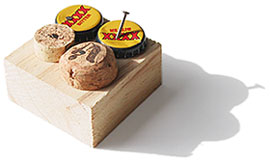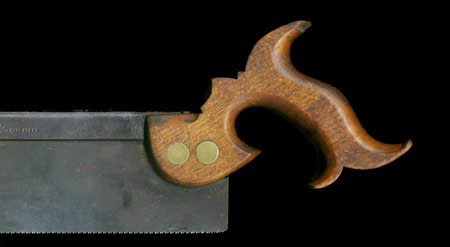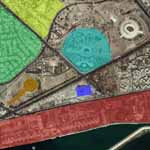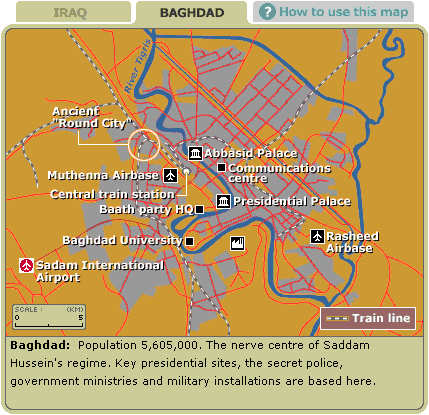Marking time in March 2003
Another toaster museum
Here is another web collection of toasters to add to the one I pointed out last year.
![Hearth toaster from the Walter Himmelreicht collection, Pennsylvania, c. 1800. Bread was placed between the arches; when one side was browned, the toaster was rotated to brown the other side. [image from toaster.org]](images/toaster-fireplace.jpg)
Woodwork
Sally made this at pre-school—beer bottle caps and slices of champagne bottle cork nailed to a piece of pine. She told me “It’s woodwork, Daddy”.

Collecting saw handles
As a harmless distraction from war and mayhem, consider the aesthetic merits of saw handles. Like this one — the beech handle of a nineteenth century dovetail saw made by Thos Turner & Co, of Sheffield.

I did not think up the idea of showing you this. I was prompted by the website of Los Angeles cabinetmaker Bob Brode, with its collection of saw handles. Here’s what he says about them:
Having looked at and held quite a few saw handles over the last few years, I’ve become intrigued with their variety. Every maker seems to have had their own twist, however slight, and many are quite handsome as purely aesthetic objects. It’s also interesting to see how differences that are visually small can have a noticeable effect on feel, especially for prolonged use. Also, over time many have acquired attractive colorations and patinas.
Baghdad blogger
Salam Pax (not his real name, surely) writes a weblog from Baghdad. It’s a gripping account of daily life in a city waiting for the onslaught.
The other day he posted a link to a high-res satellite image of part of the city, and provided a colour-coded key:

The feature most people would recognize when not seen from the top is the grand festival square (which is not a square at all. It is a semi-circle) it is in light blue. This is the one which has two huge intersecting swords at its entrance. The building below the semi-circle is the grand stand; this is the place that saw the big army marches last winter. The road to the right of it is called the Zaitoon (olive tree) Street, it has lots of olive trees obviously. On the green side of that street (the green area is a residential area called Harthiya) live many big wigs, don’t bother you CIA types reading the blog, they are empty now. The yellow area is the Zawra public garden, you see it here during the renovation period. They have just finished working on the garden. The brown longish thing down the left of the image is the clock tower of Baghdad, a very very hideous building and it houses the museum of Saddam’s presents (the ones he got from everybody, there was an article about a couple of months ago in the guardian I think). The blue square is a building that has been hit twice (desert storm and desert fox) after desert fox they decided to do a redesign since it was hit really bad. It is still unfinished but it does look nice. The red area is something I see with you for the first time. This is off boundaries to Iraqis, the whole area is a “presidential Palace”. The Sijood palace can be seen from the other side of the river and it is one of the most beautiful palaces, I really hope it does not get its “havoc recked”. I see it as a museum or some sort of academy in the future, I really like it.
Good for the environment?
An item for the ‘no, I don’t think so’ file. A silly response to a proposal for a new river bridge for walkers, bikes and buses to link the University of Queensland St Lucia campus to Dutton Park:
The car lobby, represented by the Royal Automobile Club of Queensland, is saying this is a wasted opportunity to alleviate traffic congestion. A spokesman says a general traffic bridge would ease congestion and prove to be environmentally friendly.
We think that not only would it relieve congestion, we think it would also be good for improving the environment as well because… if you move from congested to uncongested conditions then fuel consumption can be cut by about 50 per cent which means emissions are cut by 50 per cent at the same time.
Sensibly, the University is taking the opposite line. It has told the Council it does not support buses on the bridge (let alone cars and trucks). It points to the damage the roadworks and bus traffic would cause to the campus. It favours a bridge for pedestrians and cyclists.

See the City Council’s pitch for the proposal.
Mapping Iraq
The BBC website has an interactive map called Iraq navigator. It might be a handy reference in the coming weeks, as collateral damage and other spin words are dropped on us.

Iraq’s archaeological heritage at risk
The Archaeological Institute of America has urged protection of Iraq’s archaeological heritage:
As the oldest and largest organization in North America devoted to the study and preservation of the world’s cultural heritage, the Archaeological Institute of America expresses its profound concern about the potential for damage to monuments, sites, antiquities, and cultural institutions as a result of war.Iraq, the land of Mesopotamia located between the Tigris and Euphrates Rivers, is the home of some of the world’s oldest and most significant archaeological and cultural sites. One of the areas of initial agriculture and animal domestication, Iraq was the center of the development of cuneiform writing on clay tablets in ca. 3200 B.C. Numerous archaeological sites relating to Biblical history and the Sumerian, Akkadian, Assyrian and Babylonian Empires are located in Iraq, including Babylon, Ur, Ashur, Nineveh and Nimrud. Iraq’s museums, particularly the national museum in Baghdad and the regional museum in Mosul, are repositories for countless irreplaceable sculptures, inscribed tablets, reliefs, cylinder seals and other cultural objects that record this history.
The AIA therefore urges all governments, working in accordance with the terms of the Hague Convention, in concert with recognized experts in the scholarly community, to develop and implement carefully-researched programs to protect ancient sites, monuments, monuments, antiquities, and cultural institutions in the case of war. The AIA also offers the expertise of its members to assist all governments in undertaking these programs.
Ed Hamrick Fan Club
Ed Hamrick is a one-man-band software developer and the author of vuescan. When I want to squeeze the last ounce from a negative, this is the tool I reach for. The program just gets better and better. I don’t know any software vendor as helpful and responsive. Ed is a legend.
![Frequency of occurence of people with the surname 'Kyle' in the states of the USA in 1990, 1850, 1880 and 1920 [from www.hamrick.com/names/ ]](images/kyleMap.gif)
By chance, I found he has put a very nifty utility on his website — you can enter a surname and see a map of the distribution of people with that surname in the USA. You can choose from 1990, 1920, 1880 and 1850 data. The map above shows that in 1990 people called Kyle were much more common in Alaska than in South Dakota. Remarkable.
Bring in the time dimension and the picture is even more interesting. In 1850 Kyles were rare in most of the country, but one-in-a-thousand in California, Missouri, Ohio, Pennsylvania, Virginia and Maine. By 1880 many Kyles had rushed to Montana, but they did not hang around.
Thanks again, Ed.